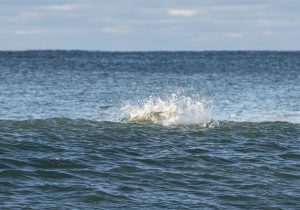Six seasoned surfcasters recently shared their knowledge on capitalizing on one of fall’s most unpredictable baitfish: the striped mullet. This seasonal migration offers anglers the chance to catch striped bass and bluefish along the Northeast coast, but timing is everything.
Navigating the Northeast Mullet Run
The striped mullet, with a distribution spanning from 42 degrees north to 42 degrees south, is a key target for gamefish in the region. While some mullet can grow to more than 10 pounds in warmer climates, the mullet common to the Northeast are typically 4- to 6-inch finger mullet, perfect bait for large bass and bluefish. Occasionally, larger mullet—often referred to as “corn cobs”—make an appearance, although these are less frequent.
The mullet run is often a short-lived, fast-paced event that begins in late summer or early fall. The fish spawn offshore during the winter months and return to brackish waters and estuaries during spring. By early fall, they begin their migration back out to sea, making them prime targets for predatory fish. This annual event is often unpredictable, with wind and weather playing a crucial role in the fish’s behavior and availability.

Timing and Location Matter
In the fall of 2023, mullet were spotted in abundance on Cape Cod, as they migrated through Nantucket Sound, creating an unforgettable fishing experience. According to surfcasters, an ebb tide combined with favorable wind conditions can push mullet across sand flats, where predatory fish wait for an easy meal. In the early morning, when water temperatures drop and air pressure is low, mullet are more likely to be found near the surfline.
Mullet Run Insights Across the Northeast
Surfcaster Dennis Zambrotta from Rhode Island mentions mullet often start appearing in salt ponds by August, remaining visible through early September. However, the duration of the run can vary significantly, with some seasons lasting only a week while others extend for up to two weeks.
On Long Island, Jake Hardy notes that mullet tend to gather near inlets by late September, with the peak run often coinciding with the first moon of October. These larger mullet, ranging between 8 and 10 inches, provide a unique opportunity for anglers as they move westward across the beaches.
In Montauk, John Papciak recalls that mullet typically stage behind inlets by late August before heading into the surf by early September. He emphasizes that the best fishing occurs just before the first nor’easter of the season, as low barometric pressure and cooler temperatures prompt mullet to begin their migration.
New Jersey’s Mullet Run
As mullet move west from Long Island, they reach the shores of northern New Jersey by late September or early October. Mike Gleason of TAK Waterman in Long Branch explains that mullet measuring between 4 and 6 inches in length typically arrive just before the first wave of peanut bunker, offering a solid meal for local striped bass.
Nick Honachefsky, a surfcaster from New Jersey, highlights that while recent mullet runs have been inconsistent, the event still signals the start of the fall fishing season. When conditions align, the presence of mullet near the shore often triggers feeding frenzies among both striped bass and bluefish, offering excellent topwater action.

Intercepting Mullet: Where and How
To successfully intercept mullet during their migration, surfcasters recommend targeting areas where mullet are forced to cross open water or navigate around structure. On Long Island, jetties, inlets, and pronounced sand structures such as pipes and troughs are prime locations where mullet get trapped, making them vulnerable to predators. Early mornings, just before dawn, are considered the best times to catch bass feeding on mullet.
A Finite Opportunity
The mullet run, while a key event in the fall migration, is often short-lived. For surfcasters from Cape Cod to New Jersey, it marks the beginning of the end for striper season. Anglers are encouraged to remain vigilant, keeping a close watch on both weather conditions and the water’s edge to ensure they don’t miss this fleeting yet exhilarating opportunity.
Images/Source: OnTheWater





